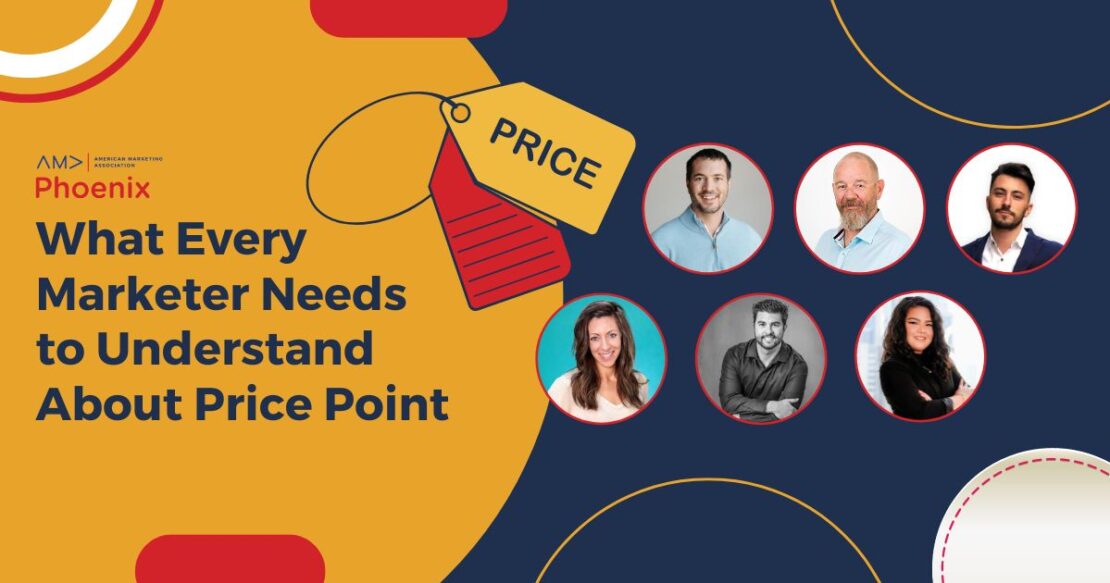- October 5, 2022
- Posted by: Featured
- Category: Blog

What is one thing every marketer needs to understand about the influence of price point in marketing strategy?
Have you ever wondered how exactly a product’s price point influences customers’ perception and chances they’ll purchase the product? You might be surprised just how many factors in a marketing strategy rely on setting a proper price. Read on below to learn what 15 marketing professionals cautioned every marketer should know about pricing before they go and implement their grandmaster marketing plan.
- Understand the Limits Customers are Willing to Pay
- Learn How to Use the Price According to Your Goals
- Diversify Your Inventory Offerings
- Don’t Forget the Competition
- Know When to Implement and Avoid Discounts
- Consider Customer Retention Levels First
- Know How Price Impacts the Customer Journey
- Balance Your Budget
- Keep Goals and Future Plans Forefront
- Drive Both Demand and Value
- Let Price Dictate the Length of the Journey
- Price Your Product Based on Demand Elasticity
- Rely on Well-Rounded Marketing Strategies
- Be the Best, Not the Cheapest
Understand the Limits Customers are Willing to Pay
Marketers need to position and price their products according to what the market is willing to pay. The way you price your products directly affects how consumers see them. Based on the demand, value, and target pricing strategies—price in a way that consumers are usually willing to pay in your industry. Disrupting the existing buying patterns is difficult—but if that’s what your goal is, sure go ahead. But at least that’s what as a marketer you must be aware of.
Daniel Close, We Buy Houses in Kentucky
Learn How to Use the Price According to Your Goals
The lower a price point, then the higher the volume. A retailer selling a product at a lower price point will sell more units, therefore their total profit may be higher than if the same product is sold by a high-end retailer, at a higher price. Marketing professionals may use the price to position a product as luxury. The price point can make your product more appealing to specific customer segments and may increase your brand’s value. Over time this could translate into higher profits.
Marco Genaro Palma, PRLab
Diversify Your Inventory Offerings
In digital marketing and advertising today price competitiveness is becoming more prevalent amongst online retailers mainly due to the ability for consumers to very easily “price compare”. For consumers who are price driven, especially with products that are available through multiple online retailers, this needs to be addressed in order to stay competitive.
However, competing on price alone in a competitive market is not the only strategy as we see companies looking to promote more varied product ranges to get traffic to their stores based on unique products instead of purely price driven products. This potentially allows businesses to separate themselves from the price driven competitiveness from online competitors and focus more on benefit driven strategies that allow the brand to influence decisions.
Russell Masters, COO of Creatively Disruptive

Price Point Influences Profit
The price point influences the level of profit a company can achieve. A small change in the pricing can raise profit significantly. This just goes to show that business leaders must not underestimate the power of pricing. Find a pricing strategy that works best for your company and allow it to work hand-in-hand with marketing. This is a powerful combination that can pack a punch!
Michelle Siy, Oliver Wicks
Don’t Forget the Competition
Until and unless you’re running a monopoly, you’re always affected by your competition—whether it’s prices, marketing, or any other business factor. Marketers must be aware of it all the time. You can’t just offer the best prices when your competitor has a better offer—this will hugely affect your marketing campaigns. And you’ll need to become more creative at justifying your prices. Or you’ll need to increase your marketing budget to run more and more campaigns, and get seen by a wider audience to extract the desired ROI. As a marketer, you should know equally about your business and your competitors.
Andrew Priobrazhenskyi, Discount Reactor
Know When to Implement and Avoid Discounts
One thing you need to understand about the price point’s influence in your marketing campaign is what customers are willing to pay, depending on a real or perceived value. Conversely, consider supply costs, competitors’ prices, seasonal discounts, and retail markup. You may want to raise the price, giving an appearance of exclusivity, or lower it to get customers on board. Determine when discounting will work. You can attract customers, but you might give the impression that the product is not so great. Take care to realize the importance of pricing to achieve successful marketing campaigns.
Lydia Boychuk, More Labs
Consider Customer Retention Levels First
When I think about price points and marketing strategy, I first try to understand the product’s (or service’s) customer retention levels. It makes zero sense to me when a company is only focused on customer acquisition campaigns when retention is declining over time. On the other hand, if customer retention is really high, you have the opportunity to look at new opportunities for enhancing your customer experience through new loyalty programs, referral programs, and/or new products and services that can enhance the overall customer experience.
Joel Polanco, Intel
Know How Price Impacts the Customer Journey
Price strategy is a powerful tool in the marketer’s toolbox. It’s also one of the original “P’s” in the marketing mix along with product, promotion, and place. The reason for its importance comes down to the perception and anchoring that it does in the mind of the consumer, and the way in which it can be manipulated to get different results.
Consumers judge quality based on price point—too low and it may be perceived as cheap, or low quality. Too high, it could backfire and drive people away—OR—like we see with Gucci, BMW, and Tesla, it promotes elitism which plays into scarcity, and therefore drives value. Discounts can be used to drive action, but too many discounts can mislead consumers to the true value of the product or service. The bottom line is knowing what your audience is willing to pay, what other competition or choices they consider when making a purchase, and how your price will impact that journey.
Ali Schwanke, Simple Strat
Balance Your Budget
Properly setting your price point is super important. When your product is priced lower than your competitors, prospects will click on your ads, banners, or visit your website. What that essentially means is that your marketing effectiveness will increase as you’ll steal more clicks and engagement. On the other hand, if your product is priced higher than the competition, you’ll need to work hard on your marketing efforts to justify those prices or get the attention of the right market. Both of these scenarios will affect your marketing budget. Therefore it is essential to find a perfect balance of pricing and to spend the perfect budget on marketing.
Joe Troyer, ReviewGrower
Keep Goals and Future Plans Forefront
Depending upon how low or high you price your product, it’s going to affect the long-range plans of your company—and this is something every marketer must be aware of. For instance, you may price your product to maximize your profits, earn better market share, stabilize the revenue, increase cash flow, or in the worst case scenarios, the goal can be just the survival of the company. You see, evaluating a better, more focused pricing strategy in your marketing efforts, can affect the future goals of your company. Keeping in mind those objectives, price your products so that you meet those goals—which are directly affected by how you price.
Robert Warner, Virtual Valley
Drive Both Demand and Value
I think the number one factor every marketer must be aware of is that you can’t just price your products based on the costs alone. Normally, what anyone would do is calculate the costs involved in the manufacturing of the product, then add profit margins, and boom. However, there are external factors smart marketers are aware of.
It’s the “demand and value”—which is ultimately based on the consumers’ end. NO price is good until and unless the consumers see the value in your product—no matter how far left you go against your competitors. Therefore, include not only costs but also the demand and value of your product in the market.
Joe Troyer, Digital Triggers
Let Price Dictate the Length of the Journey
When it comes to marketing a product or service, the price point of what you’re trying to market often dictates how long you need to nurture your target audience before they convert into customers. You should understand that impulse buys usually cost around $30 or less. Any amount above that and you’ll need to work harder to convince your ideal customer to click that checkout button. This is where the price begins influencing how you build your marketing funnel.
Anything that customers can buy on a whim don’t need complex marketing funnels. You’ll notice that you can usually build that bottom of the funnel audience much quicker and start conversion campaigns much earlier than you can with higher-priced commodities. That’s usually because you need to convince people that it’s worth investing in whatever you’re selling. The higher the price, the more work you need to put in. The more social proof you need to present, the better the benefits you have to sell.
Rain Flores, Clark Staff
Price Your Product Based on Demand Elasticity
Every marketer must be aware of this simple yet foundational pricing concept: if the demand for a product increases in the market, the pricing will automatically increase. And, in the same manner, if the demand decreases, your prices will also decrease. That’s why, before pricing your product next time, first do thorough market research. Price your product based on the demand—and not just costs. You’ll eventually need to fluctuate your prices as well—depending upon what the market decides.
Mark Valderrama, Aquarium Store Depot
Rely on Well-Rounded Marketing Strategies
Price point is one of the most important factors in marketing strategy. It can influence customer perceptions, product demand, and ultimately, company profitability. When setting price points, marketers must consider a variety of factors such as production costs, target market, perceived value, and competitor pricing. Balancing these factors will help determine an optimal price point that meets the needs of both the company and consumers.
While price point is a critical element in marketing strategy, it’s only one piece of the puzzle. In order to be successful, marketers must also create a well-rounded marketing mix that takes into account all aspects of the product or service being offered. By taking a holistic approach to marketing, companies can ensure they are maximizing their profits and reaching their target consumers.
Joe Giranda, CFR Classic
Be the Best, Not the Cheapest
Our surveys have taught us that customers perceive “cheap” poorly—likely due to years of conditioning through ads and branding. Offering the lowest price often signals you are the baseline, which can hurt your brand equity. Your competitors’ more “premium” products will be more appealing to potential customers immediately if they can afford or are willing to buy them.
It’s better to set your prices just above your competitors if you’re established. If you’re trying to penetrate a new market, discount that price point temporarily instead of applying it permanently. But price your product too high, and you’ll be limiting your market share to those who are willing to spend that much.
Jon Torres, Jon Torres
